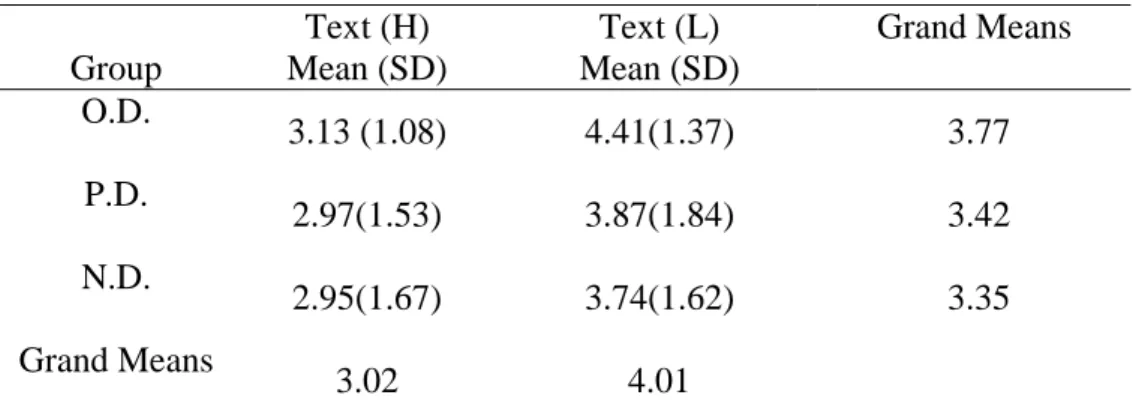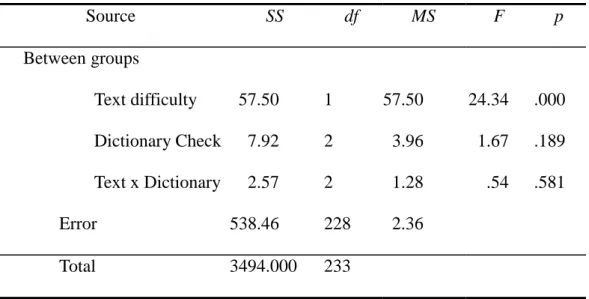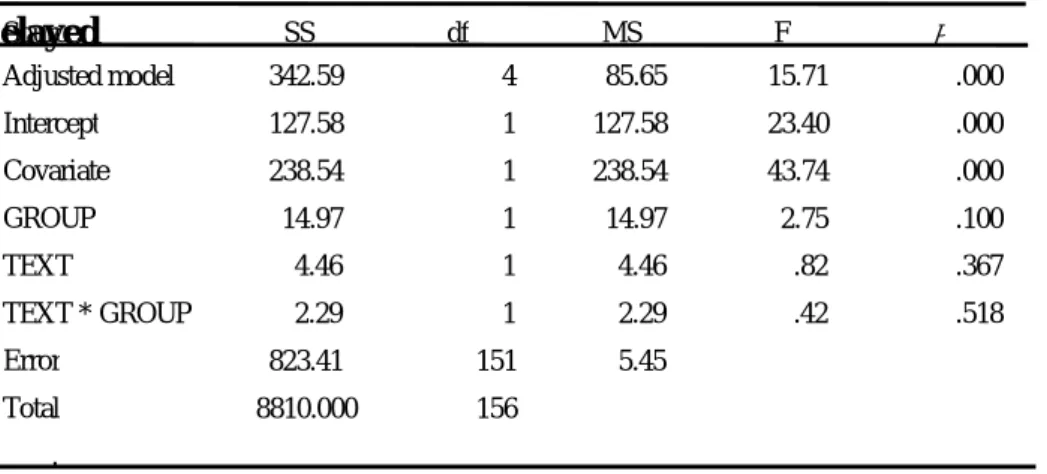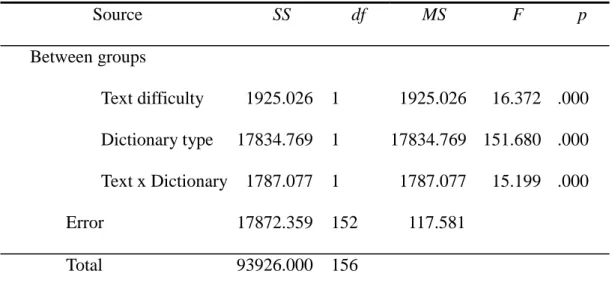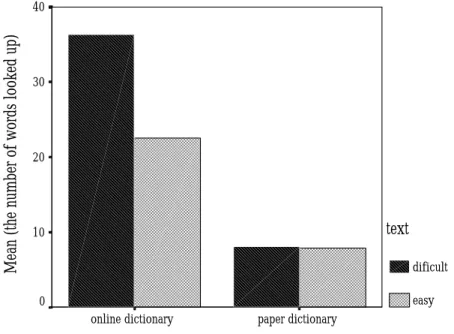CHAPTER FOUR RESULTS
This chapter presents the results from this study. Section 4.1 presents the results of the reading comprehension tests on the two articles of different levels of difficulty.
Section 4.2 presents the results of the subjects’ vocabulary retention tests. Section 4.3 explores the subjects’ lookup behavior. Section 4.4 probes the correlation among the variables. Section 4.5 presents the participants’ perceptions of using the online dictionary consultation system.
4.1 Results of Reading Comprehension
The comprehension test scores of the two given texts are showed in Table 6.
Table 6. Mean Scores and Standard Deviations (SD) for Comprehension Tests
Group
Text (H) Mean (SD)
Text (L) Mean (SD)
Grand Means O.D.
3.13 (1.08) 4.41(1.37) 3.77 P.D.
2.97(1.53) 3.87(1.84) 3.42
N.D.
2.95(1.67) 3.74(1.62) 3.35
Grand Means
3.02 4.01
Note: 1. Group (OD): online dictionary, Group (PD): conventional paper dictionary, Group (ND): no
dictionary access
2. Text (H)—the high difficult level text, Text (L)—the low difficulty level text
3. Comprehension test: 7 multiple choices, full mark=7
A two-way ANOVA was used to assess the effects of the independent variables, with three levels, online dictionary, conventional paper dictionary and no dictionary access, and text difficulty on the dependent variable, text comprehension.
Table 7. A two-way (2x3) ANOVA on Comprehension Test Scores
Source SS df MS F p
Between groups
Text difficulty 57.50 1 57.50 24.34 .000 Dictionary Check 7.92 2 3.96 1.67 .189 Text x Dictionary 2.57 2 1.28 .54 .581
Error 538.46 228 2.36
Total 3494.000 233
Although the dictionary consultation groups got higher scores on the comprehension tests than did the no-dictionary consultation group, there was no significant difference among groups on reading comprehension tests for each of the two texts. However, text difficulty significantly affected the subjects’
comprehension performance (F=24.34, p =.000 <.001). The subjects performed better on the easy text (grand mean of Text L was 4.01) than on the difficult text (grand mean of Text H was 3.02). In the study, no interaction effect between the text difficulty and dictionary check was found.
4.2 Results of Vocabulary Learning
One of the research questions is to find out whether the subjects can acquire vocabulary in reading. In this section, the results of the vocabulary retention tests are presented. Table 8 presents the mean scores the three reading groups received on the immediate vocabulary posttest.
Table 8. Mean Scores of Immediate Vocabulary Posttest
Group
Text (H) Mean (SD)
Text (L) Mean (SD)
Grand Means O.D. 6.62
a(2.02) 8.35
a(2.41)
7.49
aP.D. 6.02
a(2.65) 7.88
a(1.88)
6.95
aN.D. 5.30
a(2.05) 5.81
a(2.51)
5.56
aGrand Means
5.98
a7.34
aNote: 1. a. means the adjusted model using vocabulary pretest as covariate 2. full mark of the vocabulary posttest =12
From Table 8, we found that the grand mean of Group (OD) was 7.49, higher than 6.95 of Group (PD) and 5.56 of Group (ND). The grand mean of Group (PD), 6.95, was higher than Group (ND), 5.56. The grand mean of Text (L), 7.34, was higher than that of Text (H), 5.98.
A two-way (2x3) ANCOVA was performed to examine whether there was a
significant difference among groups on immediate vocabulary posttests. The two
independent variables were dictionary check and text difficulty. The dependent
variable was immediate vocabulary posttest and the covariate was the vocabulary
pretest. The results were shown in Table 9.
Table 9 ANCOVA on Immediate Vocabulary Posttests
438.77 6 73.13 16.82 .000
2161.06 1 2161.06 496.90 .000
189.33 1 189.33 43.53 .000
152.92 2 76.46 17.58 .000
120.30 1 120.30 27.66 .000
22.55 2 11.28 2.59 .077
987.23 227 4.35
11826.00 234
Source Adjusted model Intercept Covariate GROUP TEXT
TEXT * GROUP Error
Total
SS df MS F P
According to the result of Table 9, we found that the dictionary check had a significant effect on the immediate vocabulary posttest (F = 17.58, p = .000 < .01). In other words, there was a significant difference on immediate vocabulary posttest among groups. Second, grand mean of Text (H) was 5.98 and grand mean of Text (L) was 7.34. As we can see from Table 9, text difficulty also had a significant effect on the immediate vocabulary posttest (F = 27.66 , p = .000 <.01). Third, there was no interaction effect between text difficulty and dictionary check (F = 2.59, p = .077
>.05).
Table 10 Post Hoc Scheffe Comparison among Groups on Immediate Vocabulary Posttests
Text (H) Text (L) df F p df F p Between groups 2 3.781 .026 2 14.694 .000
Within groups 114 114
From Table10, it is found that there was significant difference among the three reader groups (p
(text H)= .0 26< .05, and p
(text L)= .000 <.05).
Though no significant interaction effect between dictionary check and text difficulty on the immediate vocabulary posttest was found, there seemed to be a slight interaction effect (F= 2.59 , p=.077, almost close to p < .05). Thus, the Post Hoc Scheffe was performed to compare between groups.
Table 11. Post Hoc Scheffe Comparison between Groups Group
I J
Mean Difference(I-J)
Std.
Error Sig. 95% Confidence Interval Lower Bound Upper Bound Text (H) OD PD
ND
.60 1.32*
.46 .47
.20 .01
-.32 1.51 .39 2.24
PD ND .721
.47
.12
-.20 1.64
Text (L) OD PD ND
.47 2.54*
.49 .49
.341 .000
-.51 1.44 1.57 3.51 PD ND
2.07* .48
.000
1.11 3.02
Note: 1. Group (OD): online dictionary, Group (PD): conventional paper dictionary, Group (ND): no
dictionary access;
2. Text (H)—the difficult text, Text (L)—the easy text
We can see from Table 11 that on Text (L), there was a significant difference between Group (OD) and Group (ND), and between Group (PD) and Group (ND).
However, no significant difference was found between Group (OD) and Group (PD).
On Text (H), significant difference was only found between Group (OD) and Group
(ND). In conclusion, we didn’t find a significant difference between Group (OD) and
Group (PD) on vocabulary posttests of the two texts. In other words, although
dictionary check will significantly enhanced vocabulary retention, no significant
effect of different types of dictionary check on vocabulary retention was found in the present study.
A delayed vocabulary posttest was conducted two weeks after the immediate vocabulary posttest and the mean scores were presented in Table 12.
Table 12. Mean Scores of Delayed Vocabulary Posttest
Group
Text (H) Mean (SD)
Text (L) Mean (SD)
Grand Means O.D. 6.73
a(2.22) 7.87
a(2.07)
7.3
aP.D. 5.91
a(3.32) 7.48
a(2.78)
6.69
aGrand Means
6.32
a7.67
aNote: a. means the adjusted model using immediate vocabulary posttest as covariate
The grand mean of Group (OD) was 7.3, higher than 6.69 of Group (PD). The grand mean of Text (L) was 7.67, higher than 6.32 of Text (H).
A two-way (2x2) ANCOVA was performed to examine whether there was
significant difference between the two dictionary access groups on the delayed
vocabulary posttest, as shown in Table 13. The independent variables were dictionary
check and text difficulty. The dependent variable was the delayed vocabulary posttest
and the covariate was the immediate vocabulary posttest.
Table 13. ANCOVA on Delayed Vocabulary Posttests D
elayed Source
342.59 4 85.65 15.71 .000
127.58 1 127.58 23.40 .000
238.54 1 238.54 43.74 .000
14.97 1 14.97 2.75 .100
4.46 1 4.46 .82 .367
2.29 1 2.29 .42 .518
823.41 151 5.45
8810.000 156
Adjusted model Intercept Covariate GROUP TEXT
TEXT * GROUP Error
Total
SS df MS F P
.
From Table 13 we found some trends. First, there was no significant difference between the two groups on the performance of the delayed vocabulary posttest (F=
2.74, p = .100 >.05). In other words, the two dictionary access groups didn’t performed differently on the memory of the word learned while reading. Second, the text difficulty didn’t affect the subjects’ long term retention performance (F= .82, p =.367>.05). Third, there was no interaction effect between text difficulty and
dictionary types (F= .419, p = .518 >.05) on delayed vocabulary posttests.
In conclusion, the long term retention performance of vocabulary learning in the
two types of dictionary check groups didn’t show significant difference on the two
texts. Besides, the results of the present experiment did not suggest that readers
tended to use electronic glosses for short-term purposes, as the investigations of Black
et al. (1992) indicated. Instead, the findings of the present study indicated that words
learned through dictionary consultation could be long-term retention. In other words,
dictionary consultation not only had a significant effect on vocabulary gain but the retention could be long term memory as well.
4.3 The Results of Frequency of Lookup Behavior
The frequency of the unknown words looked up in the dictionary was also a topic that the present study explored. Table 14 indicated the frequency of unknown words looked up in the two dictionary check groups.
Table 14. Mean Number of the Words Looked up
Group
Text (H) Mean (SD)
Text (L) Mean (SD)
Grand Means O.D. 36.28(17.75) 22.49(11.34)
29.38 P.D. 8.13(4.32) 7.87(2.81)
8 Grand Means
22.2 15.18
Note: 1. Group (OD)—online dictionary, Group (PD)—conventional paper dictionary 2. Text (H)—the difficult text, Text (L)—the easy text
From Table 14, it was found that Group (OD) looked up about three to four
times more words than Group (PD), which corresponded with the study conducted by
Aust et al.(1993). Aust’s study also indicated that hyper-reference users consulted
over two times as many word definitions as conventional dictionary users. The online
dictionary apparently increased users’ likeliness for elaboration, for it provided users
with more efficient access. One online dictionary user made 65 unique consultations
out of the 270-word article (Text H), whereas the highest number of consultations in
the paper dictionary condition was 24.
Table 15 presented the two-way ANOVA (2x2) for the effect of text difficulty and reader groups on the subjects’ lookup behavior.
Table 15. A two-way ANOVA on Lookup Behavior
Source SS df MS F p
Between groups
Text difficulty 1925.026 1 1925.026 16.372 .000 Dictionary type 17834.769 1 17834.769 151.680 .000
Text x Dictionary 1787.077 1 1787.077 15.199 .000
Error 17872.359 152 117.581
Total 93926.000 156
From the Table 15, it was found that text difficulty significantly affected the lookup behavior(F= 16.37, p = .000 <.01). When the subjects read the different difficulty levels of texts, their lookup behavior presented significant difference. The grand mean of Text (H) was 22.2 and that of Text (L) was 15.18. When they read the difficult text (H), the frequency of lookup behavior significantly became higher than if reading the easier text (L).
Second, different types of dictionary use significantly affected the frequency of lookup behavior (F= 151.68, p = .000 <.01). The grand mean of frequency of words looked up in Group (OD) was 29.38 and that in Group (PD) was 8. Obviously, Group (OD) consulted three times more words than Group (PD). Namely, online lookup
system indeed significantly motivated the subjects to do more lookup behavior.
Finally, interaction effect between the text difficulty and dictionary types (F=15.20, p=.000<.01) also significantly affect the lookup behavior of the subjects.
Figure 1 Interaction between Dictionary Types and Text Difficulty on Lookup Behavior
group
paper dictionary online dictionary
Mean (the num ber of words looked up)
40
30
20
10
0
text
dificult easy
